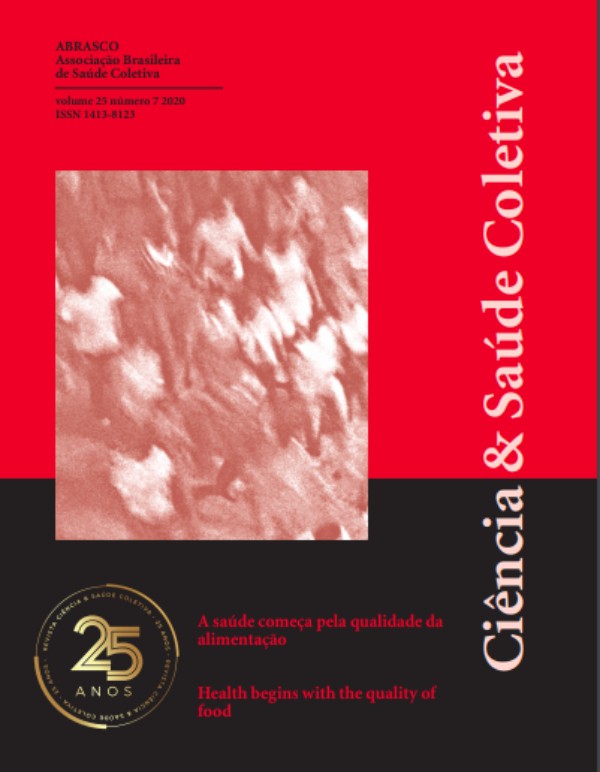0521/2018 - Género, desastres y mortalidad: Sismo en Ciudad de México, 19/septiembre/2017.
Gender, disasters and mortality: Earthquake in Mexico City, September 19th, 2017.
Autor:
• Jorge Alberto Álvarez-Díaz - Álvarez-Díaz, J.A - <bioetica_reproductiva@hotmail.com>ORCID: https://orcid.org/0000-0001-9935-8632
Resumo:
El objetivo de este trabajo fue explicar por qué murieron más mujeres en el sismo del 19 de septiembre de 2017 en la Ciudad de México. La metodología fue mixta, cuantitativa con datos epidemiológicos y estadísticos, y cualitativa con una revisión hemerográfica sobre la influencia del género en la mortalidad derivada de los sismos. Los resultados indican para la parte cuantitativa que la diferencia en las defunciones entre las mujeres respecto de las presentadas entre los hombres no puede atribuirse ni a cuestiones de distribución poblacional ni al azar. Los resultados indican para la parte cualitativa que hay muchos datos que indican que el género es un determinante social importante para explicar por qué es más frecuente que mueran más mujeres que hombres tras un sismo. Se recomienda entonces que deben considerarse estos datos de manera responsable para mejorar las acciones de prevención y de intervención a futuro.Palavras-chave:
Perspectiva de género, mortalidad, vulnerabilidad, riesgo, bioéticaAbstract:
The objective of this paper was to explain why more women died in the earthquake of September 19, 2017 in Mexico City. The methodology was mixed, quantitative with epidemiological and statistical data, and qualitative with a hemerographic review on the influence of gender on mortality derivedearthquakes. The results indicate for the quantitative part that the difference in deaths among women with respect to those presented among men cannot be attributed to issues of population distribution or randomization. The results indicate for the qualitative part that there is a lot of data indicating that gender is an important social determinant to explain why more women die than men after an earthquake. It is therefore recommended that these data should be considered in a responsible manner in order to improve prevention and intervention actions in the future.Keywords:
Gender perspective, mortality, vulnerability, risk, bioethicsConteúdo:
Acessar Revista no ScieloOutros idiomas:
Gender, disasters and mortality: Earthquake in Mexico City, September 19th, 2017.
Resumo (abstract):
The objective of this paper was to explain why more women died in the earthquake of September 19, 2017 in Mexico City. The methodology was mixed, quantitative with epidemiological and statistical data, and qualitative with a hemerographic review on the influence of gender on mortality derivedearthquakes. The results indicate for the quantitative part that the difference in deaths among women with respect to those presented among men cannot be attributed to issues of population distribution or randomization. The results indicate for the qualitative part that there is a lot of data indicating that gender is an important social determinant to explain why more women die than men after an earthquake. It is therefore recommended that these data should be considered in a responsible manner in order to improve prevention and intervention actions in the future.Palavras-chave (keywords):
Gender perspective, mortality, vulnerability, risk, bioethicsLer versão inglês (english version)
Conteúdo (article):
Gender, disasters and mortality: Earthquake in Mexico City, September 19th, 2017Dr. Jorge Alberto Álvarez-Díaz
Profesor Investigador (Titular "C")
Departamento de Atención a la Salud, UAM Xochimilco
Calzada del Hueso 1100, Col. Villa Quietud, Del. Coyoacán.
CP 04960, CDMX
bioetica_reproductiva@hotmail.com
Abstract
This paper aimed to explain why more women died in the earthquake of September 19, 2017, in Mexico City. We adopted a mixed quantitative-qualitative method, with epidemiological and statistical data and a hemerographic review about the influence of gender on earthquake-derived mortality. In the quantitative part, the results show that the difference in deaths among women compared to those among men cannot be attributed to population distribution or randomization issues. In the qualitative part, the results show that many data are evidencing that gender is an essential social determinant that can explain why more women die than men after an earthquake. Therefore, we recommend that these data be considered responsibly to improve future prevention and intervention actions.
Keywords: Gender perspective, mortality, vulnerability, risk, bioethics
Introduction
The World Health Organization says disasters occur “when a significant number of people are exposed to dangers to which they are vulnerable, resulting in injury and loss of life, in regular combination with damage to property and livelihood” . An interesting fact is that the definition does not address the origin of disasters since they are usually divided into two groups: the so-called “natural” or “non-anthropogenic” and the “non-natural”, “anthropogenic” or “anthropic”. Natural disasters include geological (earthquakes, volcanic eruptions, tsunamis), hydrometeorological (hurricanes, floods, droughts), and biological (pests, epidemics) threats. War or armed conflicts are typical examples among the non-natural ones. However, this division is as contrived as the controversial “nature vs. nurture”, “natural vs. cultural”. If human beings deforest or modify the course of a river, a threat that previously did not endanger human beings could do so. The same consideration can be made about climate change and the different distribution of vectors in the world.
The classification of disasters in “natural” and “artificial” is not entirely adequate. A “natural” phenomenon should not be threatening per se, nor should it be synonymous with disaster; its emergence is dependent on the result of a mistaken relationship between human beings and their environment. The significant flaw in these issues has been to view the environment as something contiguous to the human being, and not to be understood as part of a continuity. Human groups, with their behavior, enhance the anthropological vulnerability inherent to every human being, and with it, increase risks. Disasters are the result of the presence of a natural event, in the face of a society that has become vulnerable and put at risk . The analysis of disasters is essential from the standpoint of natural sciences, but the contributions of social sciences and humanities are also relevant, primarily to determine the extent of the damage, propose an adequate social response to them, and develop strategies for the prevention and reduction of such damages.
Knowing this, we investigated whether gender influenced increased mortality in women during the earthquake of September 19, 2017, in Mexico City.
Methods
A mixed cross-sectional quantitative-qualitative study was carried out. Regarding the quantitative part, epidemiological variables were searched and analyzed, and a hemerographic review was carried out in the qualitative part.
In the quantitative part, information was collected on the population in Mexico to identify the distribution of the population by gender, both in the country and in Mexico City. To this end, the most recent official data turned out to be the Intercensal Survey of 2015. On the other hand, we searched for official data on deaths due to the earthquake of September 19, 2017, in Mexico City. In the qualitative part, a search was conducted in the PubMed database, looking for papers that included the words “mortality”, “earthquake” and “gender”. The papers found were analyzed and those referring to another event (for example, a post-earthquake tsunami), which addressed cumulative morbidity-derived mortality (for example, deaths due to infectious post-earthquake contagions), emphasized morbidity and only mentioned mortality as a future possibility (for example, increased blood pressure or cardiovascular risk following the earthquake), those that addressed mental health issues (for example, post-earthquake suicides), and in general, those that merely mentioned the search terms but lacked data and/or reflection on the search topic were discarded. That is, if gender is related to mortality found after an earthquake.
Results
In Mexico, the 2015 Intercensal Survey showed that the population of the country had a gender distribution of 48.6% men and 51.4% women (men-women ratio of 1:0.945); Mexico City, 47.4% men and 52.6% women (men-women ratio of 1:0.901) . The figures available show 369 deaths due to the earthquake of September 19, 2017: 1 in Oaxaca, 6 in Guerrero, 15 in the State of Mexico, 45 in Puebla, 74 in Morelos, and 228 in Mexico City . According to a report by the Senate of the Republic, of the 228 deaths in Mexico City, 90 were men (39.5%), 72 adults and 18 minors, while 138 were women (60.5%), 122 adults and 16 minors (men-women ratio of 0.652) .
If in the country and Mexico City a higher proportion of women is found, could we explain a higher proportion of female deaths in this earthquake? Was it just mere chance? It is a possibility worth thinking about. However, statistical tools let us know that it is improbable. The cumulative binomial probability of obtaining x>=138 women in a total of n=228 deaths can be calculated, under the assumption that both genders have the same risk of death and therefore the expected p is similar to the proportion of women in the population, that is, 0.526. Currently, there are even online tools to perform this calculation, such as Stat Treck . Another way to calculate this probability is through logistic regression, in which the dependent variable is the risk of death in the total population and gender the independent variable. Both exercises produce similar results: 0.0001. Most probably, therefore, the explanation lies neither in the more significant proportion of women in the population (negligibly higher) nor in mere chance.
One could think of comparing the mortality data in the earthquake of September 19, 2017, with the one that occurred in the same city, precisely 32 years earlier. First disappointing surprise: there are no reliable figures. We can find estimated rates based on emergency records and not regarding the general population ; estimates based on journalistic data or groups of people interviewed ; works where health damage derived from the earthquake were published and mortality is not mentioned ; also, when performing mortality reviews for accidental injuries, the earthquake data are not recorded . Not having data, or having data that are not reliable does not allow us to make adequate estimates, draw conclusions, or make recommendations.
The above is serious, as much as the thought that mortality is not recorded by gender in the face of an earthquake. A 1977 epidemiological study analyzed the victims of the Guatemala earthquake of 1976; 22,778 people died and 76,504 were injured; the emphasis of the study is on age groups, not on differences by gender (and most of them seem to be women) . Perhaps the combination of the lack of data regarding mortality by gender and lack of knowledge about gender led to the fact that the first predictive models of mortality did not even consider the gender variable, such as that of Samardjieva and Oike , or that of Nichols and Beavers . Until very recently, the gender variable has been integrated into another model by Shapira and collaborators .
Discussion
When analyzing post-earthquake mortality divided by gender, it has been found that cases in which male mortality predominates over female mortality are rare and seem to be restricted to low-mortality earthquakes; such are the cases of Loma Prieta (1989) , and Athens (1999) . The constant is the opposite: the deaths of women in earthquakes are more significant. This is shown in the earthquakes of Ashkabad (1948), where almost two and a half times more women died than men ; Manila (1990), 55% of deaths were of women ; Kobe (1995), 59% of the victims were women . A 2013 review analyzes the period 1980-2009, finds 29 papers published in peer-reviewed and indexed journals, and only eight of them show differences by gender; in all cases, women mortality was higher than that of men . This has led to affirm that two factors greatly influence the risk of having injuries and even death after an earthquake: the place where people were and what they were doing at the time of the earthquake .
Thus, the inclusion of the gender perspective is relevant for the analysis of earthquakes. It can be affirmed that gender is an extremely relevant social determinant of health since it stratifies the population according to the exercise of power by the masculine over the feminine, and this determines standards, practices, and behaviors in society, which expose men and women differently to damages, diseases, disabilities, access to health services and participation in health research . Regarding earthquakes, this differentiated distribution according to gender mandates places men and women in different locations; it also leads them to be engaged in different activities. From a gender perspective, both research and attention should be directed to groups subordinated by gender issues , which, as intersectionality has shown, intersects with other sources of subordination .
All the above is valid in the case of disasters, bearing in mind that none is “purely natural”. Feminism has criticized the construction of epidemiology, which has traditionally assumed that the risks are distributed among the population regardless of gender, an idea that began to be questioned in the 1980s with contributions from ecological and eco-social epidemiology. This would lead to a change in the paradigm of traditional epidemiology towards situated epidemiology, which when considering variables of historical and sociocultural construction, would enhance the interpretation of health facts and help to improve prevention in health issues . In the case of disasters, it helps to understand the possibilities of survival and recovery .
It can be expected that the differences in the deaths (and injuries) of the victims of a disaster will be different between women and men due to differences in the social role they play. This causes them to be exposed to different social environments and different risks . A paradigmatic case was the Kashmir earthquake (2005), where gender roles interacted to cause women to have an increased risk of dying after the collapse of poorly constructed housing . This has been partly explained by the purdah (or pardaa) , which is a Hindu Muslim cultural practice of hiding women from men who are not their direct relatives . During the Kashmir earthquake, women who were locked up had no chance to escape; also, the sites where purdah is practiced the most had even higher mortality of women than men.
An analysis by Solis and Donají about the earthquake in Mexico suggests that the reasons to explain the mortality of women as higher than that of men would be the division of labor by gender, the type of building that collapsed, and the time of earthquake . Ultimately, the last two reasons are included in the first. The analysis of 2014 data revealed that 43% of men are almost exclusively engaged in paid work, against only 10% of women; conversely, 8% of men are engaged in unpaid work, against 43% of women. The generic role of provider continues to make women stay longer at home. We want to add that, of paid jobs, men frequently hold some positions and women others. With these considerations, the location of men and women is not equal by work type and conditions.
Solís and Donají consider that two more factors were found besides this social division of labor: the first, called “systematic”, in which most of the collapsed buildings were for housing purposes (almost 70% of buildings collapsed); the second, called “random”, the time (1:14 pm; it is said that if it had been at another time, for example at night, the distribution would have been different). Solís and Donají mention two typical examples: a collapsed office building, where the mortality of men was higher than that of women, and another building where a sewing workshop was housed, work commonly associated with women, where the mortality of women was 90%.
Given the described above, it can be concluded that the highest death of women in the earthquake of September 19, 2017, in Mexico City is statistically highly unlikely. The analysis of the literature leads to propose that it was due to gender issues.
Conclusions
Is it enough to conclude that women die more in an earthquake because of gender issues? No. There should be an impact on epidemiological surveillance as a public health tool to design prevention strategies. Responsibility is a typically philosophical issue, which is addressed by ethics. Applied ethics have been developed for life and health-related subjects, namely, bioethics, whose relevance to public health is becoming clearer by the day . Several perspectives of bioethics can help in the analysis of public health problems, such as the proposal that understands bioethics as an ethic applied at the micro, meso and macro levels .
Microbioethics is related to decisions about one’s own body and has been associated with clinical bioethics. The development of this level would have to do with the responsibility of empowering women by making them an active part of clinical decisions, both in practice and in research.
Mesobioethics has to do with institutional and structural decisions, like public policies in health, health economy, resource management, and health organizations ethics. There is no doubt that the development of public policies should include the recognition of vulnerabilities for better management of risks differentiated by gender , which should include the development of capacities to reduce risks and decrease vulnerabilities . Social participation should be understood as the participation of women as agents of change .
Macrobioethics includes global decisions, which include issues of justice worldwide, as well as the relationships between bioethics and biopolitics. It is increasingly clear that one of the negative aspects of globalization leads to increased inequities in general, and those due to gender in particular, which is why the empowerment of women must be sought . The lessons learned at the global level also show that corruption kills, particularly in the field of construction, since “analyses suggest that international and national funds set aside for earthquake resistance in countries where corruption is endemic are especially prone to being siphoned off. The structural integrity of a building is no stronger than the social integrity of the builder, and each nation has a responsibility to its citizens to ensure adequate inspection. In particular, nations with a history of significant earthquakes and known corruption issues should stand reminded that an unregulated construction industry is a potential killer” . The social determination of the health-disease-care processes should be the framework to analyze the information about the past and should be able to plan the future better.
References
World Health Organization. Environmental health in emergencies and disasters. Switzerland: World Health Organization; 2002.
García Acosta V. Los desastres en perspectiva histórica. Arqueología Mexicana. 2018;149:32-35.
Instituto Nacional de Estadística y Geografía. Encuesta Intercensal 2015. [Internet] Disponible en: http://www.beta.inegi.org.mx/proyectos/enchogares/especiales/intercensal/ [Citado el 3 de noviembre de 2018]
Animal Político. Lo que el #19S nos dejó: las víctimas, daños y damnificados en México. [Internet] Disponible en: https://www.animalpolitico.com/2017/10/cifras-oficiales-sismo-19s/ [Citado el 3 de noviembre de 2018]
Sánches Correa M, Islas Arredondo I. Recuento de los daños 7S y 19S: a un mes de la tragedia. Ciudad de México: Senado de la República; 2017. [Internet] Disponible en: http://bibliodigitalibd.senado.gob.mx/handle/123456789/3721 [Citado el 3 de noviembre de 2018]
Statistics and Probability. [Internet] Disponible en: https://stattrek.com/ [Citado el 3 de noviembre de 2018]
Sánchez-Carrillo CI. Morbidity following Mexico City\'s 1985 earthquakes: clinical and epidemiologic findings from hospitals and emergency units. Public Health Rep. 1989;104(5):482-488.
Sánchez-Carrillo CI, Moreno-Sánchez AR. La morbimortalidad debida a los sismos de septiembre de 1985 en la ciudad de México. Salud Publica Mex. 1987;29(5):389-398.
Zeballos JL. Health aspects of the Mexico earthquake – 19th September 1985. Disasters. 1986;10(2):141-149.
Híjar-Medina MC. Mortalidad por lesiones accidentales e intencionales en el Distrito Federal de 1970 a 1986. Salud Publica Mex. 1990;32(4):395-404.
Glass RI, Urrutia JJ, Sibony S, Smith H, Garcia B, Rizzo L. Earthquake injuries related to housing in a Guatemalan village. Science. 1977;197(4304):638-643.
Samardjieva E, Oike K. Modelling the number of casualties from earthquakes. J Nat Disast Sci. 1992;14(1):17-28.
Nichols JM, Beavers JE. World earthquake fatalities from the past: implications for the present and future. Nat Hazards Rev. 2008;9(4):179-189.
Shapira S, Novack L, Bar-Dayan Y, Aharonson-Daniel L. An integrated and interdisciplinary model for predicting the risk of injury and death in future earthquakes. PLoS One. 2016 Mar 9;11(3):e0151111. doi: 10.1371/journal.pone.0151111.
Eberhart-Phillips JE, Saunders TM, Robinson AL, Hatch DL, Parrish RG. Profile of mortality from the 1989 Loma Prieta earthquake using coroner and medical examiner reports. Disasters. 1994;18(2):160-170.
Papadopoulos IN, Kanakaris N, Triantafillidis A, Stefanakos J, Kainourgios A, Leukidis C. Autopsy findings from 111 deaths in the 1999 Athens earthquake as a basis or auditing the emergency response. Br J Surg. 2004;91(12):1633-1640.
Beinin L. An examination of health data following two major earthquakes in Russia. Disasters. 1981;5(2):142-146.
Roces MC, White ME, Dayrit MM, Durkin ME. Risk factors for injuries due to the 1990 earthquake in Luzon, Philippines. Bull World Health Organ. 1992;70(4):509-514.
Baba S, Taniguchi H, Nambu S, Tsuboi S, Ishihara K, Osato S. The Great Hanshin earthquake. The Lancet. 1996;347(8997):307-309.
Doocy S, Daniels A, Packer C, Dick A, Kirsch TD. The human impact of earthquakes: a historical review of events 1980-2009 and systematic literature review. PLoS Curr. 2013 Apr 16;5. pii: ecurrents.dis.67bd14fe457f1db0b5433a8ee20fb833. doi: 10.1371/currents.dis.67bd14fe457f1db0b5433a8ee20fb833.
Ardagh M, Standring S, Deely JM, Johnston D, Robinson V, Gulliver P, Richardson S, Dierckx A, Than M. A sex disparity among earthquake victims. Disaster Med Public Health Prep. 2016;10(1):67-73.
Sen G, Östlin P. Gender as a social determinant of health: evidence, policies, and innovations. En: Sen G, Östlin P. (Eds.) Gender equity in health. The shifting frontiers of evidence and action. New York: Routledge; 2010. pp. 1-46.
Hammarström A. What could a gender perspective mean in medical and public-health research? En: Wamala SP, Lynch J. (Eds.) Gender and social inequities in health – A public health issue. Lund: Studentlitteratur; 2006. p. 21-41.
Segal M, Demos V, Kronenfeld J. Gendered perspectives on medicine: an introduction. p. 1-9. En: Segal M, Demos V, Kronenfeld J. Gender perspectives on health and medicine. Key themes. Boston: Elsevier; 2003.
Jackson BE. Situating epidemiology. p. 11-58. En: Segal M, Demos V, Kronenfeld J. Gender perspectives on health and medicine. Key themes. Boston: Elsevier; 2003.
Ariyabandu MM. Sex, gender and gender relations in disasters. En: Enarson E, Dhar Chakrabarti PG. (Eds.) Women, gender and disaster. Global issues and initiatives. Thousand Oaks: Sage; 2009. p. 5-17.
Rivers JPW. Women and children last: an essay on sex discrimination in disasters. Disasters. 1982;6(4): 256-267.
Sayeed AT. Victims of earthquake and patriarchy: the 2005 Pakistan earthquake. En: Enarson E, Dhar Chakrabarti PG. (Eds.) Women, gender and disaster. Global issues and initiatives. Thousand Oaks: Sage; 2009. p. 142-151.
Hamilton JP, Halvorson SJ. The 2005 Kashmir earthquake: a perspective on women\'s experiences. Mt Res Dev. 2007;27(4):296-301.
Schuon F. Understanding Islam. Bloomington: World Wisdom; 1998.
Solís P, Donají Núñez A. ¿Por qué murieron más mujeres el 19S? Un análisis inicial. Nexos. 5 de octubre de 2017. [Internet] Disponible en: https://www.nexos.com.mx/?p=34076 [Citado el 3 de noviembre de 2018]
Hellman F, Verdi M, Gabrielli R, Caponi S. (Eds.) Bioética e saúde coletiva: perspectivas e desafios contemporáneos. Florianópolis: DIOESC; 2012.
Álvarez Díaz JA. Aspectos éticos de la nanotecnología en la atención de la salud. Ciudad de México: Universidad Autónoma Metropolitana; 2016. Disponible en URL: http://www.casadelibrosabiertos.uam.mx/contenido/contenido/Libroelectronico/nanotecnologia.pdf [Citado el 3 de noviembre de 2018]
Programa de Naciones Unidas para el Desarrollo. Superar la desigualdad, reducir el riesgo. Gestión del riesgo de desastres con equidad de género. México, DF: Programa de Naciones Unidas para el Desarrollo; 2007.
Machado de Freitas C, Lopes de Carvalho M, Francioli Ximenes E, Fonseca Arraes E, Orlando Gomes J. Vulnerabilidade socioambiental, redução de riscos de desastres e construção da resiliência: lições do terremoto no Haiti e das chuvas fortes na Região Serrana, Brasil. Cienc Saude Colet. 2012;17(6):1577-1586.
Castro García C, Reyes Zúñiga LE. Balancing gender vulnerabilities and capacities in the framework of comprehensive disaster risk management: the case of Mexico. En: Enarson E, Dhar Chakrabarti PG. (Eds.) Women, gender and disaster. Global issues and initiatives. Thousand Oaks: Sage; 2009. p. 275-288.
Molin Valdés H. A gender perspective on disaster risk reduction. En: Enarson E, Dhar Chakrabarti PG. (Eds.) Women, gender and disaster. Global issues and initiatives. Thousand Oaks: Sage; 2009. p. 18-28.
Veena N, Kusakabe K. Gender and land tenure in the context of disaster. En: Kusakabe K, Shrestha R, Veena N. (Eds.) Gender and land tenure in the context of disaster in Asia. New York: Springer; 2015.
Ambraseys N, Bilham R. Corruption kills. Nature. 2011;469(7329):153-155.













